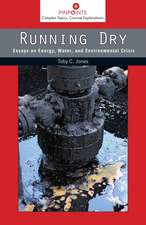Eco-hydraulic Modelling of Eutrophication for Reservoir Management
Autor Nahm-chung Jungen Limba Engleză Paperback – 11 mai 2010
Preț: 631.13 lei
Preț vechi: 880.29 lei
-28% Nou
Puncte Express: 947
Preț estimativ în valută:
120.78€ • 125.63$ • 99.71£
120.78€ • 125.63$ • 99.71£
Carte tipărită la comandă
Livrare economică 14-28 aprilie
Preluare comenzi: 021 569.72.76
Specificații
ISBN-13: 9780415573825
ISBN-10: 0415573823
Pagini: 264
Ilustrații: 50 b/w images and 50 color images
Dimensiuni: 210 x 297 x 16 mm
Greutate: 0.79 kg
Ediția:1
Editura: CRC Press
Colecția CRC Press
ISBN-10: 0415573823
Pagini: 264
Ilustrații: 50 b/w images and 50 color images
Dimensiuni: 210 x 297 x 16 mm
Greutate: 0.79 kg
Ediția:1
Editura: CRC Press
Colecția CRC Press
Public țintă
ProfessionalCuprins
Introduction. Reservoir Ecosystems. Physical Processes of Reservoirs. Physically Based Numerical Modelling. Data-Driven Modelling. Case Study: Data Acquisition and Assessment. Case Study: Construction of Models. Conclusions and Recommendations. Appendices. References.
Descriere
This study presents a systematic approach to water quality assessment, hybrid modelling, and decision support for eutrophication management in deep reservoirs. The author uses physically based modelling to understand the process of micro-scale turbulent mixing and its impact on the nutrient uptake by algae. He also delineates how a data-driven model using clustering and partial least squares regression which uses results from a physically based model of the reservoir successfully predicts Chlorophyll-a concentrations.





















